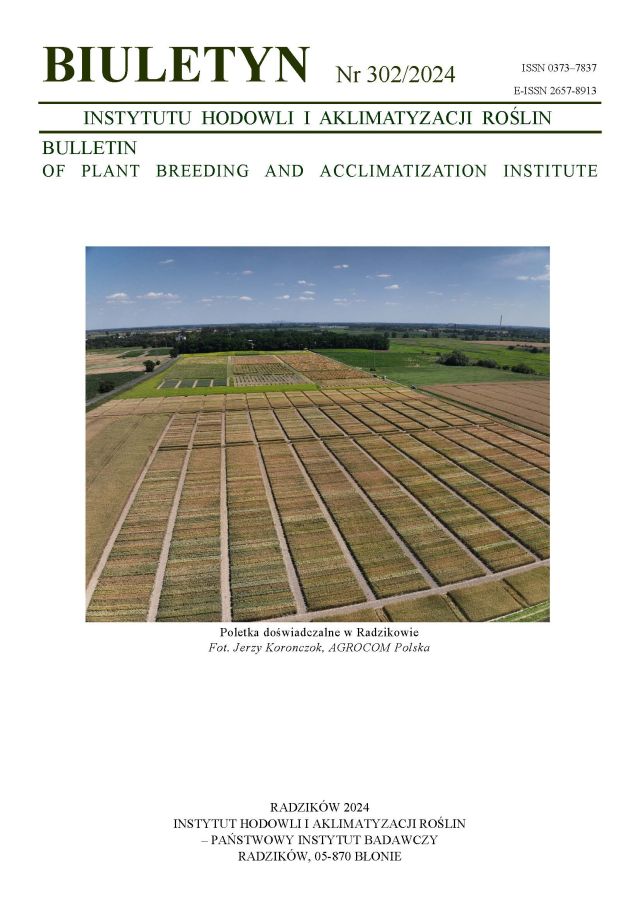Studies on the development of molecular methods for identifying genes responsible for important traits of tomato
Marzena Nowakowska
marzena.nowakowska@inhort.plInstytut Ogrodnictwa (Poland)
Urszula Kłosińska
Instytut Ogrodnictwa (Poland)
Katarzyna Nowak
Instytut Ogrodnictwa (Poland)
Wojciech Szczechura
Instytut Ogrodnictwa (Poland)
Supporting Agencies
Keywords:
bakteryjna plamistość, funkcjonalna męska sterylność, fuzaryjne więdniecie, selekcja wspomagana markeramiReferences
Gorguet, B., Schipper D., van Lammeren A., Visser R., van Heusden A. 2009. Ps-2, the gene responsible for functional sterility in tomato, due to non-dehiscent anthers, is the results of a mutation in novel polygalacturonase gene. Theor. Appl. Genet. 118: 1199 — 1209.
Google Scholar
Jinks J. L., Jones R.M. 1958. Estimation of the components of heterosis. Genetics 43: 223 — 234.
Google Scholar
Leide J., Hildebrandt U., Vogg G., Riederer M. 2011. The positional sterile (ps) mutation affects cuticular transpiration and wax biosynthesis of tomato fruits. J. Plant Physiol. 168: 871 — 877.
Google Scholar
Mather K., Jinks J. L. 1982. Biometrical Genetics. The study of continuous variation. Third edition. London, New York. Chapman and Hall.
Google Scholar
Scott J. W., Agram H. A. A., Jones J. P. 2004. RFLP — based analysis of recombination among resistance genes to fuzarium wilt races 1, 2 and 3 in tomato. J. Amer. Soc. Hort. Sci. 129 (3): 394 — 400.
Google Scholar
Smirnova A., Leide, J., Riederer M. 2013. Deficiency in a very-long-chain fatty acid β-ketoacyl-coenzyme A synthase of tomato impairs microgametogenesis and causes floral organ fusion. Plant Physiology 161 (1): 196 — 209.
Google Scholar
Staniaszek M., Szajko K., Kozik E. U., Nowakowska M., Marczewski W. 2012. The novel ps and ps-2 specific markers for selection functional male sterile lines in breeding programs and hybrids seed production. J. of Agric. Sci., vol. 4, (10): 61 — 67.
Google Scholar
Authors
Urszula KłosińskaInstytut Ogrodnictwa Poland
Authors
Katarzyna NowakInstytut Ogrodnictwa Poland
Authors
Wojciech SzczechuraInstytut Ogrodnictwa Poland
Statistics
Abstract views: 280PDF downloads: 240
License

This work is licensed under a Creative Commons Attribution-ShareAlike 4.0 International License.
Upon submitting the article, the Authors grant the Publisher a non-exclusive and free license to use the article for an indefinite period of time throughout the world in the following fields of use:
- Production and reproduction of copies of the article using a specific technique, including printing and digital technology.
- Placing on the market, lending or renting the original or copies of the article.
- Public performance, exhibition, display, reproduction, broadcasting and re-broadcasting, as well as making the article publicly available in such a way that everyone can access it at a place and time of their choice.
- Including the article in a collective work.
- Uploading an article in electronic form to electronic platforms or otherwise introducing an article in electronic form to the Internet or other network.
- Dissemination of the article in electronic form on the Internet or other network, in collective work as well as independently.
- Making the article available in an electronic version in such a way that everyone can access it at a place and time of their choice, in particular via the Internet.
Authors by sending a request for publication:
- They consent to the publication of the article in the journal,
- They agree to give the publication a DOI (Digital Object Identifier),
- They undertake to comply with the publishing house's code of ethics in accordance with the guidelines of the Committee on Publication Ethics (COPE), (http://ihar.edu.pl/biblioteka_i_wydawnictwa.php),
- They consent to the articles being made available in electronic form under the CC BY-SA 4.0 license, in open access,
- They agree to send article metadata to commercial and non-commercial journal indexing databases.
Most read articles by the same author(s)
- Wojciech Szczechura, Marzena Nowakowska, Urszula Kłosińska, Katarzyna Nowak, Krzysztof Rutkowski, Studies of cytological and biochemical mechanisms of plant resistance in the pathosystems tomato — Phytophthora infestans and cucumber — Pseudoperonospora cubensis , Bulletin of Plant Breeding and Acclimatization Institute: No. 286 (2019): Special issue
- Urszula Kłosińska, Evaluation of onion (Allium cepa L.) accessions for drought tolerance at germination and seedling growth , Bulletin of Plant Breeding and Acclimatization Institute: No. 291 (2020): Special issue
- Urszula Kłosińska, Marzena Nowakowska, Wojciech Szczechura, Katarzyna Nowak, Waldemar Treder, Krzysztof Klamkowski, Katarzyna Wójcik , Analysis of genetic and biochemical basis of onion (Allium cepa L.) tolerance to water deficit stress , Bulletin of Plant Breeding and Acclimatization Institute: No. 286 (2019): Special issue
- Urszula Kłosińska, Marzena Nowakowska, Wojciech Szczechura, Katarzyna Nowak, Waldemar Treder, Krzysztof Klamkowski, Katarzyna Wójcik , Development of genetic, physiological and biochemical basis of cucumber tolerance to water deficit stress , Bulletin of Plant Breeding and Acclimatization Institute: No. 286 (2019): Special issue














